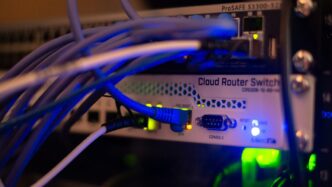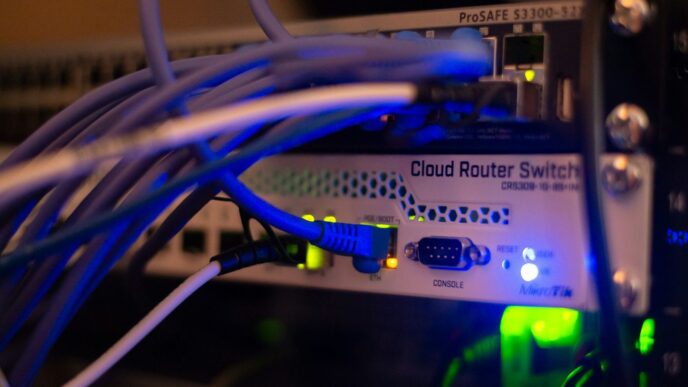October 2025 is here, and the cyber world isn’t slowing down. New ways to get hacked pop up all the time. It feels like every week there’s a new headline about a big company getting hit. Keeping your digital stuff safe means you have to know what’s going on. This update looks at the latest pentest news and what it means for you. We’ll cover some of the tricky new threats and how to get ready.
Key Takeaways
- Think about how small issues could be part of a bigger problem. Sometimes, a bunch of little things point to a major attack campaign.
- Don’t just look at the number for a vulnerability. See if it’s actually being used by attackers right now. That’s more important.
- Teams need to talk to each other. Security, IT, and other departments should work together. It makes defense much stronger.
- Keep an eye on how long it takes to spot a problem and fix it. Also, track how many times attackers tried to move around your network and you stopped them.
- Have a plan for what happens if things go wrong. This includes how you’ll get back to normal and talk to anyone who needs to know.
Understanding the Evolving Pentest News Landscape
It feels like every week there’s something new popping up in the cybersecurity world, and keeping track of it all can be a real challenge. The way attackers operate is constantly changing, and we need to keep pace. It’s not just about fixing known issues anymore; it’s about anticipating what’s next.
AI-Driven and Adaptive Malware
We’re seeing malware get smarter, almost like it’s learning. Instead of just doing the same old thing, it can change its behavior to avoid detection. Think of it like a chameleon, but for your computer systems. This makes it harder for standard security tools to catch. This adaptive nature means our defenses need to be just as flexible. It’s a cat-and-mouse game, and the mice are getting pretty clever.
Identity as the New Perimeter and Shadow AI
Remember when the "perimeter" was just the firewall around your network? Those days are pretty much gone. Now, with so many people working remotely and using cloud services, your users’ identities are often the main target. If an attacker can steal someone’s login, they might as well have the keys to the kingdom. On top of that, there’s this whole "Shadow AI" thing happening. People are using AI tools for work without IT even knowing about it. This creates blind spots and potential security risks that are hard to track.
Supply Chain and Third-Party Risk Escalation
It’s not just about your own systems anymore. A lot of businesses rely on other companies for software, services, or even just parts. This is the "supply chain." If one of those partners has a security problem, it can easily spread to you. We’ve seen this happen more and more, and it’s a big headache. It means we have to worry not only about our own security but also about the security of everyone we work with. It’s a complex web, and a weak link anywhere can cause trouble for everyone involved. Keeping up with these changes is important, especially as we head into the end of the year, and it’s good to have resources like cybersecurity awareness month to remind us of these ongoing challenges.
Emerging Threats and Pentest News for October 2025
Alright, let’s talk about what’s really cooking in the threat world this October. Things are moving fast, and frankly, it’s getting a bit wild out there. Attackers aren’t just sitting around; they’re getting smarter, and sometimes, it feels like they’re a step ahead before we even know what hit us.
AI-Powered Social Engineering and Deepfakes
This is a big one. Remember when phishing emails were just poorly written pleas for money? Those days are pretty much over. Now, attackers are using AI to whip up incredibly convincing messages. We’re seeing deepfake audio and video being used to impersonate people you trust – think your boss, a key partner, or even a family member. Imagine getting a call that sounds exactly like your CEO, urgently asking for a wire transfer. It’s not science fiction anymore; it’s happening. The sophistication of these AI-generated fakes makes them incredibly hard to spot with the naked eye.
Here’s what you need to watch out for:
- Requests that seem out of the ordinary, especially those involving money or sensitive data.
- Unusual communication methods or urgency that doesn’t fit the normal workflow.
- Any communication that feels slightly
Nation-State and Critical Infrastructure Pentest Updates
Nation-State, Hybrid Threats, and Critical Infrastructure
It’s getting pretty wild out there when it comes to nation-state actors and their focus on critical infrastructure. We’re seeing a definite uptick in cyberattacks targeting things like power grids, communication networks, and even the systems that keep our supply chains moving. Think about it: a successful attack could really mess things up for a whole region. For instance, a threat group might find a weak spot in an industrial control system and use it to shut down power. It’s not just about stealing data anymore; it’s about causing real-world disruption.
To get ready for this kind of trouble, organizations need to:
- Plan for what happens if operations get knocked offline and how to get back up and running.
- Keep critical systems separate from regular IT stuff and watch them extra closely.
- Have solid plans for when something bad happens, including knowing who to talk to, like regulators.
Quantum and Crypto-Agility Threats
While we’re not quite at the point where quantum computers are breaking all our encryption, the time to start thinking about it is now. The worry is that data stolen today could be decrypted down the road once quantum computing gets more advanced. This means sensitive information you have now could be at risk years from now. We need to get ahead of this before it becomes a full-blown crisis.
Here’s what you can do:
- Take stock of all the encryption you’re using and the types of ciphers you have.
- Start planning for crypto-agility – basically, figuring out how to switch to new encryption methods when needed. Look at which systems can be updated more easily.
- Keep an eye on standards from places like NIST and get ready to make changes as they come out.
Strategic Preparation for the Pentest News Cycle
Okay, so keeping up with all the latest security news can feel like trying to drink from a firehose, right? But seriously, if we want to stay ahead of the bad guys, we need a plan. It’s not just about reacting when something bad happens; it’s about getting ready before it does. Think of it like prepping for a big storm – you don’t wait until the wind is howling to board up the windows.
Conduct a Threat Landscape and Risk Assessment
First things first, we need to know what we’re up against. This means really digging into what threats are out there right now and how they could actually hurt our specific business. It’s not enough to just read headlines; we need to figure out which vulnerabilities are most likely to be exploited against us and what the real impact would be. This isn’t a one-and-done thing either. The threat landscape changes so fast, we should be doing this kind of assessment regularly, maybe quarterly, to catch new trends.
Here’s a quick way to think about it:
- Identify Top Threats: What are the 3-5 biggest threats facing our industry or type of business in late 2025? (e.g., AI-driven phishing, supply chain attacks, cloud misconfigurations).
- Assess Likelihood: How likely is it that we will be targeted by each of these threats?
- Determine Impact: If we are targeted, what’s the worst-case scenario? (e.g., data breach, service outage, financial loss).
- Prioritize: Based on likelihood and impact, which threats need our immediate attention?
Adopt an Identity-First Security Model
We’ve heard this a lot lately, but it’s worth repeating: identity is the new perimeter. With so many people working remotely and using cloud services, the traditional network boundary just doesn’t cut it anymore. We need to treat every access request as if it’s coming from an untrusted source, no matter where it originates. This means really locking down user accounts, devices, and applications. Multi-factor authentication (MFA) is a must, obviously, but we also need to look at things like least privilege access and continuous monitoring of user behavior. If an account suddenly starts acting weirdly, we need to know about it fast.
Enhance Threat Monitoring Capabilities
Okay, so we’ve done our homework on risks and tightened up our identity controls. Now, how do we actually see what’s happening? We need better ways to monitor our systems for suspicious activity. This isn’t just about setting up alerts and hoping for the best. It’s about having the right tools and processes in place to detect threats early, understand what they’re doing, and respond quickly. Think about monitoring things like:
- Unusual login patterns (times, locations, devices).
- Attempts to access sensitive data from unexpected places.
- Signs of lateral movement within the network.
- Anomalous network traffic.
Having good visibility means we can catch those credential theft attempts or insider threats before they cause major damage. It’s about building a security operation that’s not just reactive, but actively looking for trouble.
Key Pentest News Takeaways for Proactive Defense
Alright, let’s cut through the noise and talk about what really matters when it comes to staying ahead of the bad guys. It’s easy to get lost in the daily flood of alerts, but the real win comes from seeing the bigger picture.
Connecting Isolated Events to Coordinated Campaigns
Think of it like this: a single tripped alarm in a building might be a false positive, but a pattern of tripped alarms across multiple floors? That’s a different story. The same applies to cybersecurity. Those seemingly random blocked domains, those one-off phishing attempts, or even low-level alerts that usually get ignored – they can often be the first breadcrumbs leading to a much larger, coordinated attack. The trick is to look for these patterns, not just the individual events. By connecting these dots, you move from just reacting to problems to actually spotting and stopping campaigns before they do real damage. It’s about turning that chaotic noise into actionable intelligence.
Prioritizing Exploited Vulnerabilities Over CVSS Scores
We all know there are more vulnerabilities out there than we could ever hope to patch. So, chasing every single high CVSS score might not be the smartest use of your time. Instead, focus on what attackers are actually using in the wild. Security teams are starting to realize that understanding your specific attack surface and seeing which of your assets are being targeted is way more important than just looking at a generic score. It’s about knowing what an attacker sees when they look at your organization and prioritizing the risks that are most likely to be exploited against you.
Cross-Team Coordination for Effective Defense
No single team can win this fight alone. Security is a team sport, and that means everyone needs to be on the same page. When different departments – like IT operations, security analysts, and even development teams – work together, share information, and understand each other’s roles, the whole defense gets stronger. This collaboration helps in spotting those coordinated campaigns, prioritizing the right vulnerabilities, and ultimately, building a more resilient security posture for the entire organization. It’s about breaking down silos and working as one unified front.
Leveraging Pentest Services for Enhanced Security

Look, keeping your digital doors locked tight is a constant job, right? Cyber bad guys are always trying new tricks, and just hoping for the best isn’t really a plan. That’s where professional penetration testing, or pentesting, comes in. Think of it like hiring a security expert to try and break into your systems, but in a controlled way, so you can fix the weak spots before the real attackers find them.
Comprehensive Website Penetration Testing
Your website is often the first place customers interact with your business. If it’s got holes, that’s a big problem. We’re talking about things like making sure no one can sneak in and steal customer data through SQL injection or cross-site scripting (XSS) attacks. A good website pentest looks at all the angles, using up-to-date tools and methods to find those hidden flaws. It’s about making sure your public face is secure.
Internal Penetration Testing for Insider Threats
Not all threats come from the outside. Sometimes, the danger is already inside the building, whether it’s a disgruntled employee or someone who accidentally clicked on a bad link. Internal pentesting simulates these scenarios. It checks how far someone could get if they managed to get past your initial defenses, looking for ways to escalate their access or move around your network undetected. This gives you a clear picture of your internal security posture.
Targeted Mobile Application Penetration Testing
Got an app for your customers? Great! But is it safe? Mobile apps can have their own set of vulnerabilities, like insecure ways of storing data or unexpected ways information can leak out. A targeted pentest for your mobile app digs into the code and how it communicates to find these issues. It’s a specific kind of check for a specific type of digital product that’s become super common.
Wrapping Up: Staying Sharp in 2025
So, that’s a look at what’s brewing in the cyber world for October 2025. It’s clear that things aren’t slowing down, and attackers are getting smarter, especially with AI playing a bigger role. Remember, just having a firewall isn’t enough anymore. We need to think about how we spot trouble, how fast we can react, and how we bounce back when things go wrong. Keeping an eye on new threats, like those related to quantum computing, and making sure our defenses can keep up is key. Working with folks who know their stuff, like VaporVM, can really help make sure you’re not left behind. Don’t forget to check that list of quick steps we shared – it’s a good starting point for making sure your systems, data, and people are ready for whatever comes next.
Frequently Asked Questions
What is AI-driven malware and why is it a big deal?
Imagine computer viruses that can change their appearance and behavior on the fly, making them super hard for regular security software to catch. That’s AI-driven malware. It uses artificial intelligence to learn and adapt, making attacks faster and more sneaky than ever before.
What does ‘Identity as the New Perimeter’ mean?
Think of your company’s digital doors and windows. In the past, a strong firewall was like a fortress wall. Now, with people working from everywhere and using lots of different apps, your employees’ login details and digital identities are the main way attackers try to get in. So, protecting those identities is super important.
How are attackers using deepfakes and AI for trickery?
Attackers are using AI to create fake videos or voices that look and sound exactly like someone you know, like your boss. They might use this to trick you into sending money or giving away secret information. It’s like a super advanced form of tricking people online.
Why is the ‘supply chain’ important for cyber security?
Your supply chain is all the companies you work with, like your software providers or vendors. If one of these partners has weak security, attackers can use them as a back door to get into your own systems. It’s like a weak link in a chain that can break the whole thing.
What is ‘Shadow AI’ and why is it risky?
Shadow AI is when employees use AI tools for work without the company knowing or approving them. These unapproved tools might not be secure and could accidentally leak company data or create new security problems that nobody is watching.
What does ‘crypto-agility’ mean and why should I care?
Crypto-agility is about being ready to switch your digital security codes (encryption) quickly if new, more powerful computers (like quantum computers) come along that can break the old codes. It means making sure your security systems can adapt to future threats.














